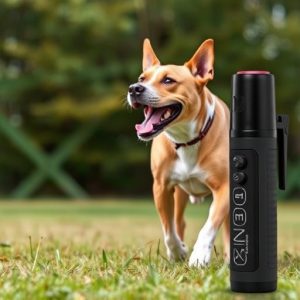Maximizing Dog Pepper Spray Effectiveness with OC Percentage Understanding
The OC Percentage (Oleoresin Capsicum) in canine pepper spray is key to effectiveness, indicating ca…….
The OC Percentage (Oleoresin Capsicum) in canine pepper spray is key to effectiveness, indicating capsaicin concentration. Higher percentages mean stronger effects but must be balanced with safety—aim for 2% to 5% AIC/OC. Proper formula and spray mechanism are crucial. Knowledge of OC% aids users in choosing products tailored to threat levels and animal sensitivity, and in applying the spray effectively. Reputable brands prioritizing quality and safety are best. Training involves gradual desensitization with low-percentage sprays, ending on positive notes, while safety tips include ventilation, reach control, recall practice, and monitoring for reactions.
“Dogs, man’s best friend, can now protect themselves with a unique defense mechanism—dog pepper spray. This innovative tool offers a non-lethal way to deter potential threats. In this article, we explore the science behind canine pepper spray, focusing on the crucial OC (Oleoresin Capsicum) percentage for maximum effectiveness. We’ll guide you through choosing the right spray and provide essential training tips for safe and responsible use. Get ready to unlock your dog’s protective capabilities.”
- Understanding OC Percentage: The Key to Canine Pepper Spray Effectiveness
- Choosing the Right Dog Pepper Spray: Factors to Consider for Optimal Protection
- Training and Safety Tips: Responsible Use of Pepper Spray for Dogs
Understanding OC Percentage: The Key to Canine Pepper Spray Effectiveness
Understanding OC (Oleoresin Capsicum) percentage is crucial for assessing the effectiveness of canine pepper spray. This measure indicates the concentration of capsaicin, the active ingredient responsible for the burning sensation and subsequent disability. A higher OC% means more capsaicin, which translates to a stronger and longer-lasting effect on an attacker. However, it’s not just about strength; proper distribution is key. The formula and spray mechanism play significant roles in ensuring the pepper spray reaches its target effectively, maximizing its impact.
Knowing the OC% helps dog owners and handlers make informed decisions when choosing a pepper spray designed for canine use. It allows them to select products that match their specific needs based on potential threat levels and animal sensitivity. Moreover, understanding this percentage enables users to apply the spray appropriately, aiming for the eyes and face of an aggressor, where it will cause the most discomfort and disable the attacker temporarily, providing precious time for escape or assistance.
Choosing the Right Dog Pepper Spray: Factors to Consider for Optimal Protection
When selecting a dog pepper spray, understanding the Active Ingredient Concentration (AIC) or OC percentage is paramount. Look for sprays with an OC range between 2% and 5%. This concentration offers an effective balance—enough to deter intruders without causing excessive irritation or pain. Opting for a lower OC might not provide adequate protection, while a higher concentration could lead to unpleasant side effects for both your dog and the intended target.
Other factors come into play as well. Consider the spray’s range: a longer reach ensures better protection during unexpected encounters. Check the spray pattern; a wide, even distribution of the mist improves coverage. Additionally, weight and size matter, especially when considering travel or storage. A lighter, compact design is easier to carry but might have shorter-range effects. Always choose a reputable brand that prioritizes quality and safety in their production processes.
Training and Safety Tips: Responsible Use of Pepper Spray for Dogs
Training your dog to respond appropriately to pepper spray is a crucial aspect of ensuring its safe and responsible use. Start by desensitizing your canine companion to the scent and irritant through simulated training sessions. Use a low concentration of OC (oleoresin capsicum) percentage in the spray, typically around 2-5%, during these exercises. Gradually increase the intensity as your dog becomes accustomed to the sensation, always ending on a positive note with treats and praise. This prevents associating the spray with fear or punishment.
Safety tips are paramount when introducing pepper spray to your pet. Ensure the area is well-ventilated during training sessions to minimize inhalation issues. Keep the spray out of reach of children and other pets to prevent accidental use. Regularly review recall commands with your dog, as you would in any training regimen, to ensure they remain effective during unexpected situations. Additionally, keep a close eye on your dog’s behavior after each session, monitoring for any adverse reactions, especially if they have sensitive respiratory systems or pre-existing health conditions.
In conclusion, dog pepper spray can be an effective tool for personal protection when used responsibly. Understanding the OC (oleoresin capsicum) percentage is crucial to its effectiveness, and choosing the right spray tailored to your needs ensures optimal protection. With proper training and safety precautions, owners can empower themselves and their pets to deter potential threats, enhancing both peace of mind and canine safety.


